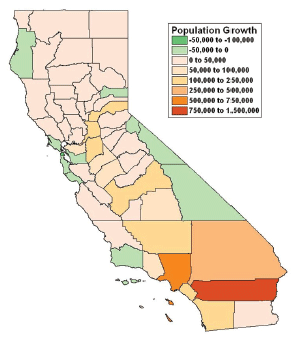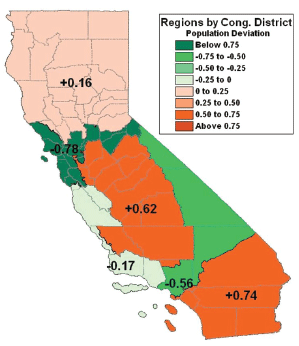 Over the last decade, California’s population center has shifted away from coastal urban centers and moved farther inland. While almost all areas of California have increased in population and most Californians still live in coastal counties, the growth in inland areas has far outpaced that of the coastal region. As a result, when Congressional districts are redrawn following the 2010 Census, the Inland Empire and other inland areas stand to increase their representation at the expense of other parts of the state. The Rose Institute recently released a report titled “The 2010 Census: Congressional Reapportionment,” which analyzes the population shifts and predicts how they may affect redistricting.
Over the last decade, California’s population center has shifted away from coastal urban centers and moved farther inland. While almost all areas of California have increased in population and most Californians still live in coastal counties, the growth in inland areas has far outpaced that of the coastal region. As a result, when Congressional districts are redrawn following the 2010 Census, the Inland Empire and other inland areas stand to increase their representation at the expense of other parts of the state. The Rose Institute recently released a report titled “The 2010 Census: Congressional Reapportionment,” which analyzes the population shifts and predicts how they may affect redistricting.
The U.S. Supreme Court requires that states redraw Congressional district lines each decade to equalize population between districts. California currently has 53 Congressional districts and will likely have the same number after the next Census. The state will thus need to redraw the 53 districts to ensure that each has an equal number of constituents.
It has been nearly a decade since the last redistricting in 2001, and population shifts over the past decade have produced major population imbalances in the state’s Congressional districts. Several Riverside County Congressional seats are particularly over-populated. Mary Bono Mack’s Palm Springs-based
45th district has the largest population in the state with over 962,000 residents, more than thirty-six percent over the 2010 population ideal. Bono Mack’s district splits the majority of Riverside County with Representative Ken Calvert’s 44th district, the second largest in the state. Calvert’s district is currently twenty-six percent over the ideal, with 892,423 residents. Two other districts represent parts of Riverside County: Darrell Issa’s 49th district and Jerry Lewis’s 41st district. Issa’s district is the third most populous in the state and eighteen percent over the ideal, while Lewis’s is the seventh most populous and thirteen percent over the ideal.
 San Bernardino County’s Congressional districts are also over-populated. Rep. Lewis’s 41st district, which covers much of San Bernardino County, is thirteen percent over the ideal. Buck McKeon’s 25th district, geographically the second largest in the state, covers much of the rest of San Bernardino County and is sixteen percent over the population ideal, the fourth most overpopulated in the state. Other districts that have part of their population in San Bernardino County are David Dreier’s 26th district, Gary Miller’s 42nd district, and Joe Baca’s 43rd district. The first two are not particularly over-populated, but Baca’s is the fifth most in the state at fourteen percent above the ideal.
San Bernardino County’s Congressional districts are also over-populated. Rep. Lewis’s 41st district, which covers much of San Bernardino County, is thirteen percent over the ideal. Buck McKeon’s 25th district, geographically the second largest in the state, covers much of the rest of San Bernardino County and is sixteen percent over the population ideal, the fourth most overpopulated in the state. Other districts that have part of their population in San Bernardino County are David Dreier’s 26th district, Gary Miller’s 42nd district, and Joe Baca’s 43rd district. The first two are not particularly over-populated, but Baca’s is the fifth most in the state at fourteen percent above the ideal.
In contrast to these overpopulated inland districts are coastal districts like those of San Francisco Bay Area Representatives Nancy Pelosi, Jackie Speier, and Barbara Lee. These coastal districts are under-populated by seventeen, fourteen, and fourteen percent, respectively.
Overall, the inland congressional districts are currently at about 1.7 congressional seats over the ideal; conversely, the coastal districts are under-populated by the equivalent of 1.7 seats. We group the Inland Empire together with Orange County and San Diego County when analyzing the movement of congressional seats. That combined area stands to gain almost three quarters of a congressional seat in the 2011 redistricting, thanks to its estimated population gain of approximately 1.45 million over the last decade, by far the largest gain of any of the regions.
In the 2011 redistricting, line drawers will reconfigure existing Inland Empire districts to reduce their total population. They will then shift the surplus population either to a new Inland Empire-based district, or to nearby districts that require additional population. In either event, this change will shift district lines from the coast toward the Inland Empire.
There is an increasing ideological divide between California’s more Democratic coastal areas and its more Republican inland areas. As the state’s Congressional districts shift inland, the California congressional delegation may grow somewhat more conservative. However, it is also possible that in 2011 Congressional district lines will be redrawn in such a way as to preserve the current ideological balance of power and so we may see no such transfer of seats from the Democrats to the Republicans.

Sorry, comments are closed for this post.